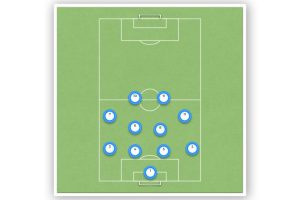Wing Play Soccer Tactics for Teams with Small Forwards: Maximizing Your Attack
As a soccer coach, I know that teams with smaller forwards often struggle to create scoring opportunities. However, one effective tactic that can help small teams overcome this challenge is wing play. By getting the ball to the wings, players can create space and take advantage of their speed and agility to beat defenders and create chances.
Wing play is a versatile tactic that can be used in a variety of formations, from classic 4-4-2 to more modern 3-4-3 or 4-3-3. The key is to have skilled wingers who can cross the ball accurately, receive the ball in tight spaces, and pass with precision. A good winger should also have great pace and agility so they can beat defenders on the outside and move quickly up and down the pitch.
In this article, I will explore different wing play tactics that can be used by teams with small forwards. I will examine the benefits of wing play, provide tips for developing skilled wingers, and explore different formations and strategies that can be used to maximize the effectiveness of this tactic. Whether you’re a coach looking to improve your team’s attacking prowess or a player looking to take your game to the next level, this article will provide valuable insights and actionable advice to help you succeed.
The Importance of Wing Play
As a coach of a team with small forwards, I have found that wing play can be a crucial tactic to create scoring opportunities. By utilizing the width of the field, we can stretch the opposing defense and create space for our forwards to exploit.
Wing play is particularly effective against teams that play with a narrow defensive shape. By sending our wingers wide, we can force the opposing fullbacks to come out and defend, leaving gaps in the center of the defense for our forwards to run into. Additionally, wing play can create overloads on the flanks, allowing our team to create numerical advantages in certain areas of the field.
Another benefit of wing play is that it can help us retain possession of the ball. When our team is under pressure, we can play the ball out wide to our wingers, who can then hold the ball up and allow our team to reorganize and build an attack from a more secure position.
| Benefits of Wing Play | |
|---|---|
| Creates space for small forwards | Exploits gaps in defense |
| Stretches opposing defense | Creates overloads on the flanks |
| Helps retain possession of the ball | Allows team to build attacks from secure position |
Soccer Tactics for Teams with Small Forwards
1. Starting Positions and Roles
When playing with small forwards, it is essential to have a formation that suits their strengths. A 4-3-3 formation can work well, with the forwards playing narrow and close to each other. The central forward should be the tallest and strongest player, while the wingers should be fast and agile. They should be comfortable playing in tight spaces and have the ability to beat defenders one-on-one.
2. Movement Off the Ball
Off-the-ball movement is crucial for teams with small forwards. The forwards should make runs into the channels, creating space for the wingers to exploit. They should also drop deep to receive the ball and link up with the midfielders. The wingers should make diagonal runs towards the goal, looking to get in behind the defense. The midfielders should support the forwards and wingers by making overlapping runs and creating passing options.
3. Overlapping Runs and Crosses
One effective tactic for teams with small forwards is overlapping runs and crosses. The full-backs should push forward and overlap the wingers, creating two-on-one situations against the defenders. The wingers should then cut inside and look to cross the ball towards the central forward or the opposite winger. The full-backs should also be able to deliver crosses into the box, allowing the forwards to attack the ball in the air.
4. Switching the Play
Switching the play is another tactic that can be useful for teams with small forwards. By quickly switching the ball from one flank to the other, the team can create space and catch the opposition off guard. The wingers should be able to switch positions, allowing the full-backs to overlap and create width. The midfielders should be comfortable playing long balls, switching the play and creating counter-attacking opportunities.
5. Counter-Attacking Opportunities
Teams with small forwards can be devastating on the counter-attack. By quickly transitioning from defense to attack, they can catch the opposition off guard and create scoring opportunities. The central forward should be able to hold up the ball and wait for support from the midfielders and wingers. The wingers should be quick and direct, looking to beat defenders and create chances. The midfielders should be able to make runs into the box and support the attack. Overall, teams with small forwards can be successful by playing to their strengths and using tactics that suit their style of play. By focusing on off-the-ball movement, overlapping runs, switching the play, and counter-attacking opportunities, they can create scoring chances and compete against bigger and stronger opponents.
Drills and Exercises to Improve Wing Play
1. One-on-One Dribbling and Crossing Drill
In this drill, I set up a 20×10 yards area with a goal at each end. I divide the players into two teams and assign each team a wing player and a defender. The wing player starts with the ball and tries to dribble past the defender and cross the ball to their teammate at the other end. The defender tries to stop the wing player from crossing the ball. The teams switch roles after each attempt.
2. Overlapping Runs Drill
This drill focuses on the wing player’s ability to make overlapping runs and deliver crosses. I set up a 30×20 yards area with a goal at each end. I divide the players into two teams and assign each team a wing player and a fullback. The wing player starts with the ball and passes it to the fullback, who makes an overlapping run. The wing player then receives the ball back from the fullback and delivers a cross to their teammate in the box.
3. Small-Sided Game with Limited Touches
This drill emphasizes the importance of quick decision-making and accurate passing. I set up a 40×30 yards area with small goals at each end. I divide the players into two teams and play a 4v4 game with limited touches. Each player is only allowed two touches on the ball, which encourages them to think and act quickly. The wing players are encouraged to take on defenders and deliver crosses into the box.
4. Counter-Attacking Game Simulation
This drill simulates a game situation where the team is defending and looking to counter-attack quickly. I set up a 50×40 yards area with a goal at each end. I divide the players into two teams and play a 7v7 game. The defending team starts with the ball and tries to play it out to their wing players, who then look to quickly counter-attack and deliver crosses into the box.
Conclusion
Based on my research and knowledge, wing play is an effective soccer tactic for teams with small forwards. By taking the ball wide and changing attacking angles, teams can pull defences out of shape and create space for their forwards to exploit.
During training, coaches can focus on drills that help players improve their dribbling, crossing, and finishing skills. For example, a drill where players practice crossing from the wing and another where players practice finishing from crosses can be helpful.
It’s important to also consider the team’s formation when implementing wing play tactics. A formation with wingers, such as the 4-3-3 or 3-5-2, can work well with this tactic. However, it’s important to ensure that the team has the right players who are fit and can help out at the back.
| Pros | Cons |
|---|---|
| Creates space for small forwards to exploit | Requires skilled wingers and fullbacks |
| Can pull defences out of shape | Can leave the team vulnerable on the counter-attack |
| Allows for attacking from different angles | Requires a lot of practice and coordination |
Overall, wing play can be a valuable addition to a team’s tactics, especially when playing against teams with strong central defenders. However, it’s important to ensure that the team has the right players and formation to execute this tactic effectively. With the right training and practice, wing play can be a game-changer for teams with small forwards.







